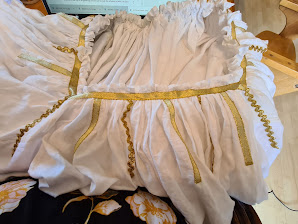I decided I wanted to make a petticoat as part of my under layer. I have a red silk petticoat I often wear under my dresses and I find it does a great job of adding shape to my skirts. I have had some fabric that I've been meaning to turn in to one for some time now so this seemed like a great opportunity! I have no evidence that Portuguese women wore a petticoat but it is interesting that Alcega has a number of examples of under and over skirts in Libro de Geometria which is only separated from my chosen area by 60 years and one border. It seems to be very plausible that Portuguese women would have worn some kind of underskirt to support the over layers. I am also not planning on making a kirtle to go under my dress as I want to wear it in one of the hottest parts of the year. Hopefully my petticoat will give me extra volume in my skirt without adding extra warmth!
I had a good look through the faldellin and vasquina patterns in Alcega. I was very taken with the vasquina de feda para muger gorda which is pattern number 58. This translates as a "kirtle of silk for a fat woman".
Image from https://www.wdl.org/en/item/7333/view/1/132/
I am in fact a fat woman so this greatly appealed to me!
The fabric I am using is pretty but not especially authenic. It is an embroidered polyester taffeta. Normally I would prefer to use silk but as it was taffeta meant it had the body I wanted to provide support. Its other big selling point was the embroidery which is done by machine and not authenic in design. It is however very pretty and reasonably priced. The last two points overcame my concern about authenticity. As it is a petticoat it is not going to be seen by anyone except me and my nearest and dearest so it is not the end of the world!




















